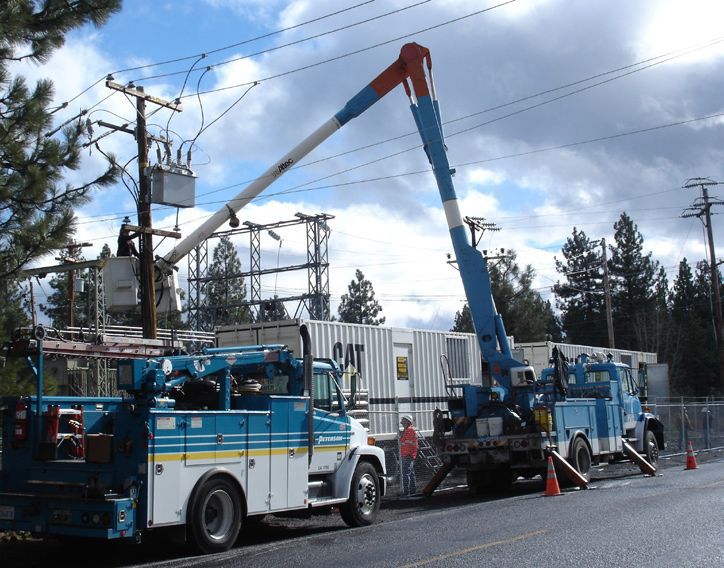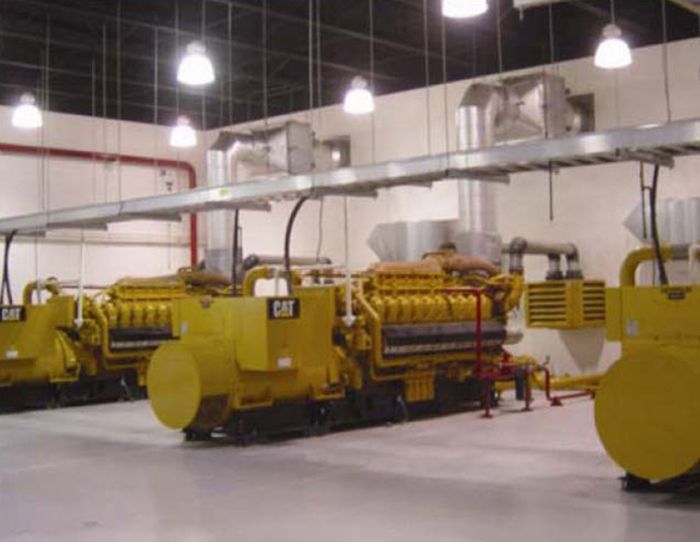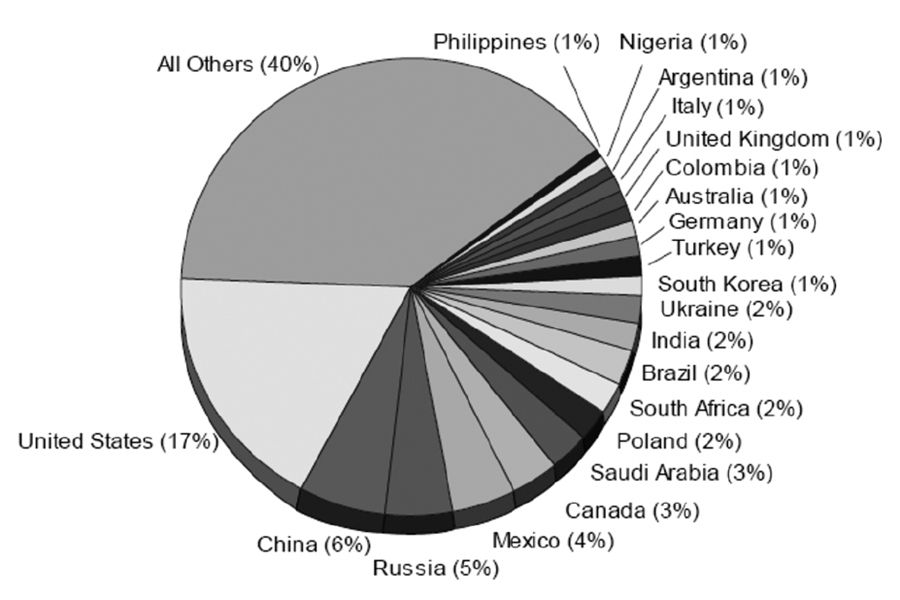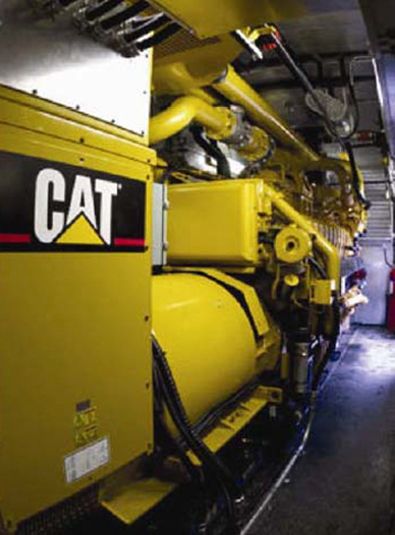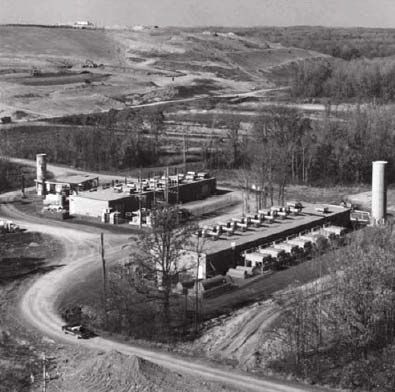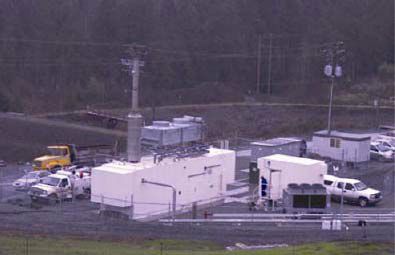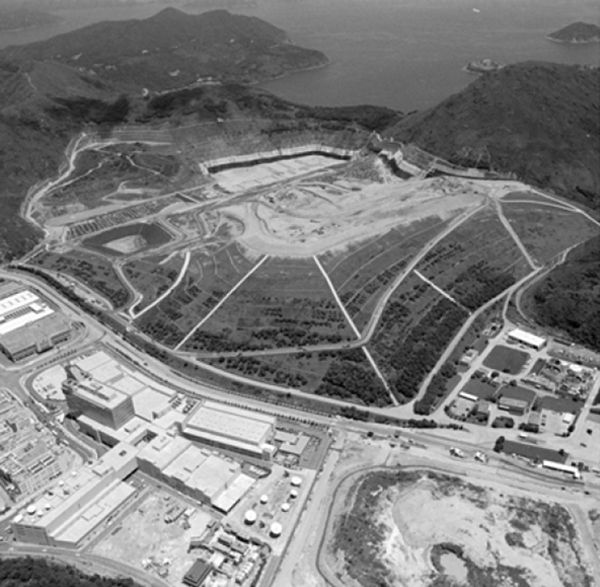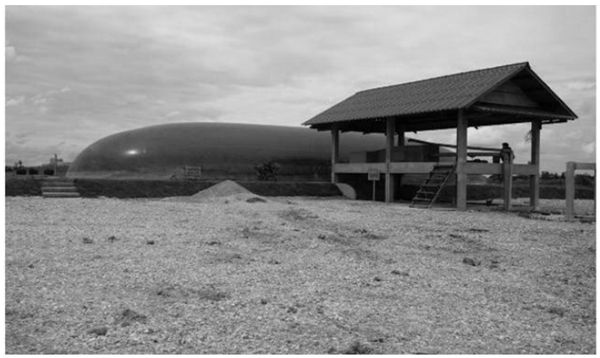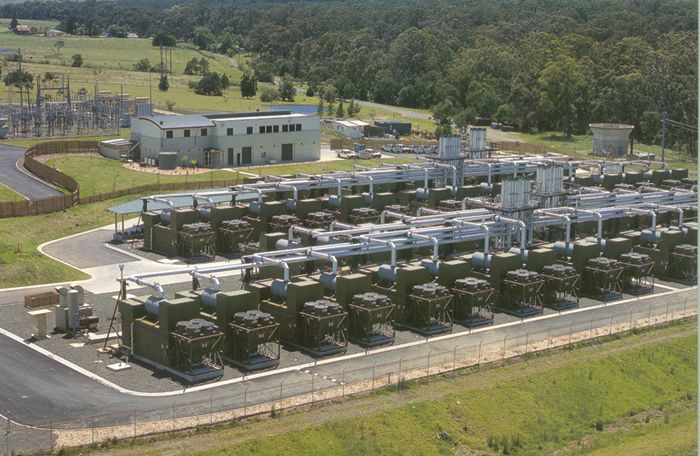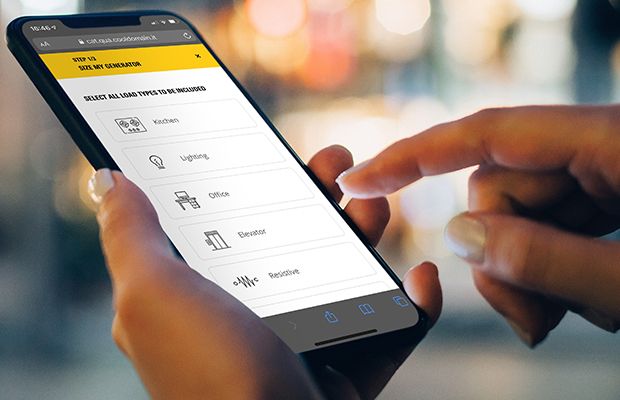Case 2 – Open-Market Price Hedging [3]
The volatility in the energy market was greatly affecting the power department budget in the city of Hurricane, Utah. Its population surged from 8,250 in 2000 to 12,084 in 2006 – an increase of 46.5 percent. That growth put stress on the municipal power system, operated by Hurricane City Power, especially in the summer when temperatures can exceed 110°F. This demand, coupled with high prices on the energy market, forced the city to dip into budgetary reserves to pay for power a few years in a row.
In order to diversify its electric supply options, Hurricane turned to natural gas generator sets. The city’s new generator sets would have to meet Hurricane’s needs – load following, summer peaking and open market price-hedging strategies. Hurricane also needed to boost end-of-line voltage and frequency for distribution system enhancement.
Over a period of three years, six Cat® G3520C natural gas generator sets with Cat Oxidation Catalysts were installed (see Fig. 2). The catalysts lower emissions of carbon monoxide by 93% and decrease hydrocarbons by more than 40%, greatly reducing the generator sets’ environmental impact. One of these units serves the nearby city of Washington and is used when supplemental power is needed there. The generator sets are rated at 1,940 ekW at 1800 rpm, in 115°F temperature and at an elevation of 3,000 feet. They operate together with paralleling switchgear at 12,470 V. This power is connected directly to the adjacent substation’s distribution buss.
The reliability and cost-effectiveness of this power solution earned Hurricane City Power and Washington City Power a joint award in 2007 for the “Most Improved System of the Year” from the Utah Associated Municipal Power Systems (UAMPS). The city has been able to save as much as $10,000 to $12,000 a day because of their ability to react to market prices quickly, and run their generators instead of buying power on the market when the cost is high. In addition to cost savings for the city, the gensets provide peak power production support and backup power in case of a citywide blackout. Three area blackouts have occurred in the three years since this system has been in place, and the gensets have provided the power needed to get the city up and running with no outside power available.
Case 3 – Combined CHP and Standby Power for Hospital [4]
A cost effective combined heat and power (CHP) and standby power generation package was required for the Norfolk and Norwich Hospital being built by Octagon Healthcare in the United Kingdom. In addition, tariff quality metering was necessary to qualify the CHP as eligible for payment under the Climate Change Levy “Good Quality CHP” scheme.
Rather than the usual basement plant room, a stand-alone energy center was built to give better access for servicing and supplies. The CHP system prime mover is a Cat G3516 leanburn gas engine. Heat is recovered from the engine exhaust, jacket water and oil cooler circuits, to provide 1314 kW. It is used heat the returning medium-pressure hot water before it re-enters the boiler, so the CHP acts as lead boiler. When thermal demand is low excess heat is dumped to a remote radiator. A Cat SR4 generator directly linked to the engine provides 400 volts at 50 Hz. This feeds a synchronizing circuit breaker inside a control panel, in turn connected to the hospital’s HV line via a step-up transformer. The complete system is displayed on a graphical overview; a simple touch of the screen is all that is required for an operator to interact with the system.
The standby generation system comprises four 2250 kVA (1800 kW) Cat 3616B diesel generator sets guarding against utility failures. Generators work in an “n+1” configuration so that full coverage of the hospital power requirements continues if one set is unavailable; say due to servicing at the time of power failure. The generators are connected to the hospital heating and ventilation power feed via a HV switchboard. Like the CHP system, the master control panel provides a graphical overview of the system. Restoration to utility power, once service has been deemed to be back to normal, is fully automatic. The system is tested monthly with a real disconnection from the utility supply.
Case 4 – Landfill Applications [5]
Landfill-gas-to-energy embodies the ideal solution to an environmental problem: it turns nuisance waste into a product with a practical use and economic value. It is an important and growing component of North America’s power generation mix. Generation from municipal solid waste and landfill gas is projected to increase to about 31 billion kilowatt-hours by 2025 [6]. Although the U.S. leads in this category, landfill gas is globally available as the chart below illustrates [7].
Landfill gas (LFG) is produced naturally as organic waste decomposes in landfills. LFG is composed of about 50 percent methane, about 50 percent carbon dioxide and small amounts of non-methane organic compounds. At most municipal solid-waste landfills, the methane and carbon dioxide are destroyed in a gas collection and control system or utility flare. However, to use LFG as an alternative fuel, the gas is extracted from landfills using a series of wells and a vacuum system. Pipes are inserted deep into the landfill to provide a point of release for the landfill gases. A slight vacuum is then applied in the pipe to draw the gases into and through it to a central point, where it can be processed and treated for use in generating electricity, replacing the need for conventional fossil fuels. Here are a few examples from around the world of how LFG is used to produce electric power through engine generator sets (see Fig. 4) in landfill configurations.
Seneca Meadows Landfill, Seneca Falls, New York
This energy system, owned by Innovative Energy Systems of Oakfield, NY, began operation in 1996 and has been expanded three times to its current 11.2 MW capacity. The system (see Fig. 5) uses fourteen Cat G3516 generator sets that have been modified for landfill use. Overall energy plant NOx emissions are compliant with local air-quality standards.
Hartland Landfill in Victoria, British Columbia, Canada
The landfill receives municipal solid waste from a population of roughly 400,000. Until the power generating system went online, the landfill gas had been flared. Independent power producer Maxim Power Corporation of Calgary, Alberta, installed the land-fill-gas-to-energy system (see Fig. 6). The electric energy output (continuous duty at 1.6 MW) is being sold to BC Hydro for that company’s Green Power program.
South East New Territories Landfill, Hong Kong
This site operated by Green Valley Landfill Ltd., installed two Cat G3516 landfill generator sets in 1997. Each unit is rated at 970 kW, providing 1.9 MW of continuous power for the landfill infrastructure and an on-site wastewater treatment plant (see Fig. 7). The units operate in parallel with the local utility, exporting excess power to the grid. The generator sets have oversized radiators to compensate for tropical heat and humidity.
Case 5 – Biogas Applications [8]
Biogas is produced through the natural anaerobic decomposition or fermentation of organic waste, such as manure, municipal solid waste, biodegradable waste or any other biodegradable feedstock within an anaerobic environment. Biogas consists primarily of methane (50-80 percent) and carbon dioxide (20-50 percent). Biogas can be extracted for commercial use from almost any of its sources. For example, some livestock farms or large feeder operations use a lagoon to store the manure generated by their livestock.
Instead of releasing the methane and carbon dioxide generated by the decomposition of this manure into the atmosphere, the methane can be extracted and burned at the farm in biogas-fueled boilers, heaters or other gas consuming devices, including gas engines. In addition to livestock farms, other agricultural operations afford opportunities for biogas productions.
For example, cassava-processing plants, which produce starch, are common in China, India and Indonesia and may utilize biogas for electric power. By tapping their biogas resources, these plants not only avoid the cost of purchasing heavy fuel oil and electricity but also reclaim valuable land that would otherwise have to be used to purify the factory’s wastewater, and virtually eliminating odor and pest issues caused by large-scale decomposition of organic material.
As an example of this type of DG application, let us consider the Nong Rai Farm, in Rayong, Thailand. The farm partners with the CP Group, one of the largest food suppliers in Thailand, and runs a feeder operation for more than 30,000 hogs. Nong Rai Farms consumes approximately 200 kW of power for blowers, drying systems and other auxiliary needs associated with its operations. The manure produced by its hogs is piped into a digester pond (see Fig. 8), where it generates biogas that is used to fuel the generator sets, which produce sufficient power for all of Nong Rai Farm’s electric power requirements.
Case 6 – Coal Mine Methane (CMM) Gas Applications [9]
The anthropogenic release of methane (CH4) into the environment and its global warming potential continues to draw attention globally. Methane can be released into the atmosphere through sources where it naturally occurs: landfill decomposition, agriculture, gas and oil extraction systems, and coal mining activities. About 8% of total anthropogenic methane emissions come from coal mines [10].
Globally, coal mines emit approximately 400 million metric tons or 28 billion cubic meters of carbon dioxide equivalent annually. This amount is equivalent to consumption of 818 million barrels of oil or the carbon dioxide emissions of 64 million passenger cars. Between 1994 and 2005, U.S. emissions decreased by over 20%, in large part due to the coal mining industry’s increased recovery and utilization of drained gas. China leads the world in coal mine methane with about 14 billion cubic meters of CO2 emitted annually – a 2004 measurement estimated nearly 200 million metric tons were emitted that year. Aside from the U.S. and China, other leading emitters include Ukraine, Australia, Russia and India.
Once methane is released into the atmosphere it remains in it for approximately 15 years. It is a greenhouse gas with an estimated global warming potential of 21. This means that emissions of methane have an estimated effect on global warming equal to 21 times the effect of carbon dioxide. Implementing methods to use CMM instead of emitting it to the atmosphere will help mitigate global warming, improve mine safety, and productivity and generate revenues and cost savings.
There are several options currently available for CMM mitigation, including reciprocating gas engines, gas turbines, industrial boilers and furnaces, and chemical processing. Other technologies like catalytic systems and fuel cells are also being developed. Two examples of this type of DG application are described next, where CMM is sequestered and used as an alternative fuel for reciprocating gas engine generator sets. This is a mature and proven technology highly effective for greenhouse gas mitigation.
Appin and Tower Coal Seam Energy Project in Australia
The Appin and Tower project (see Fig. 9) is one of the largest coal seam gas energy systems in the world and one of the world’s largest engine-generator installations of any kind. The Appin and Tower projects consume 600,000 m3 of coal seam gas per day from two separate mines in New South Wales, Australia. Supplementing with natural gas when necessary, the Appin and Tower project uses more than 90 Cat G3516 lean burn generator sets, each of which produces 1,030 kW of continuous power. As of the summer of 2008, most units had completed over 80,000 hours of operation.
Sihe Mine in Jingcheng, Shanxi Province of China
Sixty Cat G3520C generator sets with low energy fuel packages run on CMM at the Sihe mine in Jingcheng, Shanxi province of China (see Fig. 10). The Cat G3520C operates at 1500 rpm with a continuous rating of 1,966 ekW under standard operating conditions. An open combustion chamber design allows it to operate using low-pressure gas supplies of just 5 to 35 kPa (0.7 psi to 5 psi). The low boost pressure requirement reduces the installation cost of the fuel treatment systems often found in low-energy fuel environments.
When fully commissioned, the sixty generator sets will produce over 108 MW of electric power. Additionally, the exhaust will be recovered and used to drive steam turbines to produce an additional 12 MW of electric power. The eventual production target is a combined 120 MW with jacket water heat recovery for hot water production. This project is the largest of its kind in the world.
SUMMARY
The prevailing focus of this paper is distributed generation systems based on engine driven generator sets (gensets). However, in many instances, alternate DG technologies could have been used to achieve comparable results. Several DG applications have been presented ranging from backup power to greenhouse gas mitigation systems. With such a wide spread range of applications, it is undeniable that DG has a profound and positive impact on society. To name a few … power outage avoidance, keeping critical operations and life safety equipment running, providing a safety net in volatile energy markets with wild price fluctuations, creating power from sustainable resources (landfill, biogas, and coal seam gas), mitigating release of greenhouse gases, reducing their environmental impact and global warming effects. DG has become woven into the fabric of the electric power generation infrastructure. They diversify the electric power generation portfolio, promote economic growth in areas that otherwise would starve from lack of power, and improve quality of life for those using them.
REFERENCES
- IEEE Standard 1547, “Standard for Interconnecting Distributed Resources with Electric Power Systems”, Published by IEEE, New York, NY, July, 2003.
- Power Profile, “Pacific Gas and Electric Company”, Caterpillar publication LEXE0012-00, October 2008.
- Power Profile, “Hurricane City Power”, Caterpillar publication LEXE8829-00, May 2008.
- Power Profile, “Octagon Healthcare Limited”, internal Caterpillar document.
- Michael Devine, “Dealing with Landfill Fuel”, internal Caterpillar document.
- Annual Energy Outlook 2004 with Projections to 2025, U.S. Energy Information Administration, U.S. Department of Energy.
- United States Environmental Protection Agency. “Global Anthropogenic Emissions of Non-CO2 Greenhouse Gases 1990-2020”. EPA Report 430-R-06-003. Retrieved August 7, 2008 from http://www.epa.gov
- John C.Y. Lee et al, “Sustainable Application of Reciprocating Gas Engines Operating on Alternate Fuels”, internal Caterpillar document.
- John C.Y. Lee et al, “Sustainable Application of Reciprocating Gas Engines Operating on Coal Mine Methane Gas”, internal Caterpillar document.
- United States Environmental Protection Agency. “Methane”, Retrieved 6 June 2008 from EPA Web site http://www.epa.gov/methane/
ACKNOWLEDGEMENTS
This paper leverages work from several people at Caterpillar. The author is particularly thankful to Mike Devine, John Lee, Thomas Teo, Peter Lau, Choon Hwa Tnay, and Don Dentino.


